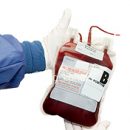Nasal bleeding in frequency occupy the first place among spontaneous bleeding, and amount to data from different sources 3-5% of the total number of hospitalized in ENT hospitals.
Content
Differences in the number and nature of nasal bleeding, with other things being equal conditions, is not marked between male and female floors.
Nose bleed
More often arises suddenly and may be accompanied by significant blood loss. The basis of nasal bleeding is the violation of the integrity of the vascular wall or the blood coagulation disorders. Nasal bleeding can be spontaneous or caused by various injuries. The causes of nasal bleeding are made to divide local and general.
To local reasons include:
-
With the surface arrangement of the vascular plexus in the nose partition it is easy to damage, which becomes the most common cause of all nasal bleeding (90% of cases);
-
injuries that can be of different strength – From it all seemingly harmless habit of picking a finger in a nose to significant, accompanied by fractures of the bones of the facial skeleton;
-
foreign bodies in the nasal cavity, which can provoke bleeding, directly traumating the mucous membrane, or causing inflammation at the location of their long stay. This is especially true for young children who often get into the nose various subjects, after which they forget about it or hide from adults. In this case, the bleeding is accompanied by purulent with an unpleasant odor;

-
various benign and malignant nasal cavity tumors (children are most often benign);
-
The curvature of the nasal partition, where, along with periodic bleeding, in most cases, the difficulty of nasal breathing will be observed;
-
Anomalies for the development of the vascular system of the nose – various localization of the expansion of the arteries and veins;
-
changes in the structure of the mucous membrane under various infections (tuberculosis, syphilis, diphtheria) and chronic cold;
-
Nasal bleeding in children may arise due to the fact that the air indoor air. The drying mucous membrane of the nasal septum shanks with the wall of the blood vessel and they lose their elasticity and strength. As a result, with sneezing, blowing off, etc. This dry mucous membrane cracks and breaks the blood vessel with her.
The causes of nasal bleeding
Diseases or conditions accompanied by violations of coagulation properties of blood and their combination with violation of the permeability of the vascular wall:
-
Blood diseases (for example, hemophilia – congenital pathology characterized by the absence or deficiency of one of the coagulation factors);
-
increasing the permeability of vessels in their inflammation (vasculitis) arising from severe infections such as measles, flu, etc.;
-
with a lack of vitamin C (hypovitaminosis C);
-
in hereditary diseases characterized by violations in the structure of the vascular wall;
-
chronic liver diseases (hepatitis, cirrhosis);
-
chronic inflammatory diseases of the cavity of the nose and the incomplete sinuses;
-
States accompanied by the rise of blood pressure (renal hypertension – Increased blood pressure in kidney disease, exercise, solar strike, overheating).
Nasal bleeding can start suddenly, often during sleep. Bleeding is one-sided or immediately from both half the nose. Bleedings are of different intensity and duration. In some cases, blood flows slowly and spontaneously stops, in other blood streams, the bleeding can continue long and spontaneously does not stop.
It is important to understand that the resulting nose bleeding, even in case of injury, may be the first sign of formidable diseases (for example, blood diseases) and subsequently have a recycling recurrent (repeated) current. In all cases, the development of nasal bleeding requires consultation of specialists, and to begin the examination follows from a visit to the Children's ENT, which will examine the nasal cavity, prescribes the radiography of the apparent sinus nose.
If the causes of nasal bleeding are local, and in particular – Surface vessels in a nasal partition, a specialist can carry them out (coagulation) in various ways: electricity, laser (electrical or laser coagulation) or liquid nitrogen (cryosium).
Testimony for vessels are recurring nasal bleeding (sometimes they are repeated several times a week and bring significant inconvenience to the patient); unsuccessful attempts to stop bleeding in other ways; pronounced bleeding; Development as a result of repeated bleeding anemia (Malokrovia), the exhaustion of the body. In the presence of foreign bodies in the nasal strokes, polyps are shown their removal and t.D. If the reasons for bleeding are common, then various surveys will be appointed, for example, blood tests, as well as additional consultations of other specialists: hematologist (doctor dealing with blood diseases), pediatrician and t.D.
Chronic bleeding
Is the reason for slowly growing exhaustion of the body, the formation of anemia. Anemia suffers immunity – reduced resistance to causative agents of disease and constantly changing environmental conditions. Chronic oxygen starvation determines the appearance of a pathological condition, in which irreversible changes in the structure and functions of most human bodies occurs.
Loss of blood in a large volume leads to severe consequences for the body, and in some cases to death. Bleeding can be sharp and chronic. Acute bleeding causes a rapid deterioration in the state of the patient and in a short period of time can lead to loss of consciousness as a result of acute oxygen starvation of the brain, and in case of impossibility of stopping – For fatal outcome.









